 I recently visited an exhibit at the Oregon Museum of Science & Industry called Body Worlds 3. I was only vaguely familiar with what I was about to see. I knew that there would be human bodies on display and that they were in poses that allowed you to see how the body works. They were also skinless. That's right, I said skinless.
I recently visited an exhibit at the Oregon Museum of Science & Industry called Body Worlds 3. I was only vaguely familiar with what I was about to see. I knew that there would be human bodies on display and that they were in poses that allowed you to see how the body works. They were also skinless. That's right, I said skinless. At first I was a little disgusted at the idea, then I thought this could be educational and interesting. I am glad I decided to attend. The first body I saw was the Skinless Man (pictured to the right). He is nearly 6 feet tall and holding his own skin draped over his right hand. He was encased in glass, but I was still able to get very close to him. Many of the other displays were not in glass and I could get right next to them to get a closer look than I would have ever imagined.
You may be "thinking this is disgusting", or "how could they do this to human beings", or even "who would want to see this". Well don't worry. It was very tastefully done. All of the bodies are treated with the utmost respect. All of them are voluntary donors to the program, much like the bodies donated for medical research. The whole purpose of the exhibit is to allow the lay person to view and get a better understanding of how the human body works and the effects of various stresses and diseases.
Another FAQ is "does it smell?". No. The bodies are put through a process called Plastination developed by Dr. Gunther von Hagen. Plastination is a unique method of preserving tissue in a like-like state. It is a vacuum process in which biological specimens are impregnated with reactive polymers like rubber, epoxy or polyester resin.. Plastinated specimens are dry, odorless, durable and last indefinitely.
Every display in the exhibit is unique. Each specimen is displayed in a different position. To achieve this, the bodies are anatomically dissected prior to Plastination. Once the silicone permeates the body, it is then posed, tented and treated with light or heat that hardens the polymer.
In addition to whole bodies, there are also internal organs in various states of health. You may see a healthy set of lungs next to smoker's lungs which are next to lungs ravaged by cancer. There are hearts, livers, kidneys and many others.
You know whether or not you can stomach the sight of a human with no skin. That is only the tip of the iceberg, though. You will also see bodies with their chest cavities opened up for a view of the internal organs. You may see the skull cap removed for a better view of the brain. There is one display where the man is in a walking position but his head and torso are split in two places and his body is fanned out (hold up your pointer, middle and ring finger and spread them out).
The entire exhibit takes about an hour and a half to get through. A limited number of tickets are sold each hour to prevent huge crowds and to allow the visitors to view as much as they want with as little interruption as possible. This is a traveling exhibit, and while it may not be for everyone, I highly recommend you see it if you can.
For more information, go to http://www.bodyworlds.com/.
I have posted some pictures of the exhibits below if you are interested in seeing more.
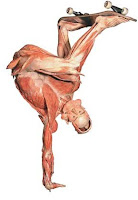
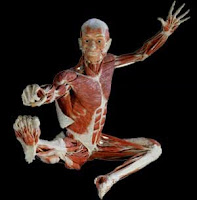
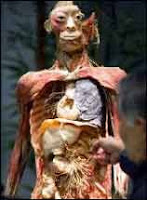
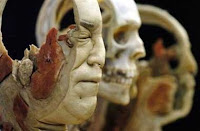

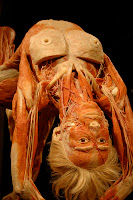
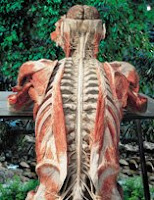
All images belong to Body Worlds and their partners.







